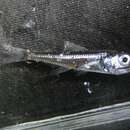Migration
provided by Fishbase
Oceanodromous. Migrating within oceans typically between spawning and different feeding areas, as tunas do. Migrations should be cyclical and predictable and cover more than 100 km.
Trophic Strategy
provided by Fishbase
High-oceanic, mesopelagic. Nyctoepipelagic at the surface and down to 125 m and found between 225-750 m during the day. Feeds on copepods, euphausiids, zoea stages of Brachyura and fish fry (Ref. 4479). Preyed upon by swordfish and cod (Ref. 5951).
- Recorder
- Drina Sta. Iglesia
Biology
provided by Fishbase
High-oceanic, mesopelagic (Ref. 4479). Nyctoepipelagic at the surface and down to 125 m and found between 225-750 m during the day (Ref. 4479). Feeds on copepods, euphausiids, zoea stages of Brachyura and fish fry (Ref. 4775). Sexually mature when 5 cm long. Female produces 8-900 eggs (Ref. 35388).
Comprehensive Description
provided by Smithsonian Contributions to Zoology
Myctophum punctatum
This is a large myctophid, known to grow to about 107 mm (Hulley, 1981). All specimens of this “uncommon” lanternfish taken during the Ocean Acre program were either juveniles 17–23 mm or postlarvae 7–18 mm. The 51 specimens were taken as follows: 9 in March, 14 in April, 27 in June, and one in September. Myctophum punctatum is a subpolar-temperate species (Backus et al., 1977), and probably is found near Bermuda only as a distributional waif from its center of abundance to the north. Zurbrigg and Scott (1972) concluded that M. punctatum did not spawn in the northwest Atlantic, but Jahn's (1976) report of several 16–20 mm juveniles from the presumed expatriate area of those authors suggests that additional study is needed to determine the reproductive status of this lanternfish in the northwestern Atlantic.
VERTICAL DISTRIBUTION.—Nearly half (24) of the specimens were caught in neuston nets at night. One specimen was caught at 50 m at night and another, a postlarva, at 33 m during daytime. The remaining eight discrete-depth captures were made during crepuscular periods, seven at 701–800 m, and one 251–300 m.
- bibliographic citation
- Gibbs, Robert H., Jr. and Krueger, William H. 1987. "Biology of midwater fishes of the Bermuda Ocean Acre." Smithsonian Contributions to Zoology. 1-187. https://doi.org/10.5479/si.00810282.452
Myctophum punctatum
provided by wikipedia EN
Myctophum punctatum is a species of mesopelagic fish in the family Myctophidae. Its common name is spotted lanternfish, sometimes spelled spotted lanterfish. It is found in the Northern Atlantic and in the Mediterranean at depths down to 1000m.[1] It is one of the dominant species in midwater assemblages near the Mid-Atlantic Ridge.[2]
Myctophum punctatum can grow to 11 cm (4.3 in) SL.[1] It performs diurnal migrations to the surface at dusk.[3] It feeds mostly on copepods and euphausiids.[4]
Larvae of Myctophum punctatum have stalked eyes.[5]
References
-
^ a b Froese, Rainer; Pauly, Daniel (eds.) (2014). "Myctophum punctatum" in FishBase. November 2014 version.
-
^ Sutton, T. T.; Porteiro, F. M.; Heino, M.; Byrkjedal, I.; Langhelle, G.; Anderson, C. I. H.; Horne, J.; Søiland, H.; Falkenhaug, T.; Godø, O. R.; Bergstad, O. A. (2008). "Vertical structure, biomass and topographic association of deep-pelagic fishes in relation to a mid-ocean ridge system" (PDF). Deep-Sea Research Part II: Topical Studies in Oceanography. 55 (1–2): 161–184. Bibcode:2008DSRII..55..161S. doi:10.1016/j.dsr2.2007.09.013.
-
^ Nicol, J. A. C. (2009). "Spectral composition of the light of the lantern-fish, Myctophum punctatum". Journal of the Marine Biological Association of the United Kingdom. 39: 27–32. doi:10.1017/S0025315400013072. S2CID 3562442.
-
^ Scotto di Carlo, B., G. Costanzo, E. Fresi, L. Guglielmo, & A. lanora (1982). "Feeding ecology and stranding mechanisms in two lanternfishes, Hygophum benoiti and Myctophum punctatum". Marine Ecology Progress Series. 9: 13–24. Bibcode:1982MEPS....9...13S. doi:10.3354/meps009013.
{{cite journal}}: CS1 maint: uses authors parameter (link) -
^ Catul, V.; Gauns, M.; Karuppasamy, P. K. (2010). "A review on mesopelagic fishes belonging to family Myctophidae". Reviews in Fish Biology and Fisheries. 21 (3): 339–354. doi:10.1007/s11160-010-9176-4. S2CID 42988401.

- license
- cc-by-sa-3.0
- copyright
- Wikipedia authors and editors
Myctophum punctatum: Brief Summary
provided by wikipedia EN
Myctophum punctatum is a species of mesopelagic fish in the family Myctophidae. Its common name is spotted lanternfish, sometimes spelled spotted lanterfish. It is found in the Northern Atlantic and in the Mediterranean at depths down to 1000m. It is one of the dominant species in midwater assemblages near the Mid-Atlantic Ridge.
Myctophum punctatum can grow to 11 cm (4.3 in) SL. It performs diurnal migrations to the surface at dusk. It feeds mostly on copepods and euphausiids.
Larvae of Myctophum punctatum have stalked eyes.
- license
- cc-by-sa-3.0
- copyright
- Wikipedia authors and editors
Diet
provided by World Register of Marine Species
Feeds on copepods, euphausiids, zoea stages of Brachyura and fish fry
North-West Atlantic Ocean species (NWARMS)
- license
- cc-by-4.0
- copyright
- WoRMS Editorial Board
Distribution
provided by World Register of Marine Species
Western Atlantic: Greenland to USA
North-West Atlantic Ocean species (NWARMS)
- license
- cc-by-4.0
- copyright
- WoRMS Editorial Board
Habitat
provided by World Register of Marine Species
High-oceanic, mesopelagic, nyctoepipelagic at the surface and down to 125 m and found between 225-750 m during the day.
North-West Atlantic Ocean species (NWARMS)
- license
- cc-by-4.0
- copyright
- WoRMS Editorial Board
Habitat
provided by World Register of Marine Species
nektonic
North-West Atlantic Ocean species (NWARMS)
- license
- cc-by-4.0
- copyright
- WoRMS Editorial Board
Habitat
provided by World Register of Marine Species
Epipelagic
Census of Marine Zooplankton, 2006. NOAA Ship Ronald H Brown, deployment RHB0603, Sargasso Sea. Peter Wiebe, PI. Identifications by L. Bercial, N. Copley, A. Cornils, L. Devi, H. Hansen, R. Hopcroft, M. Kuriyama, H. Matsuura, D. Lindsay, L. Madin, F. Pagè
- license
- cc-by-4.0
- copyright
- WoRMS Editorial Board

